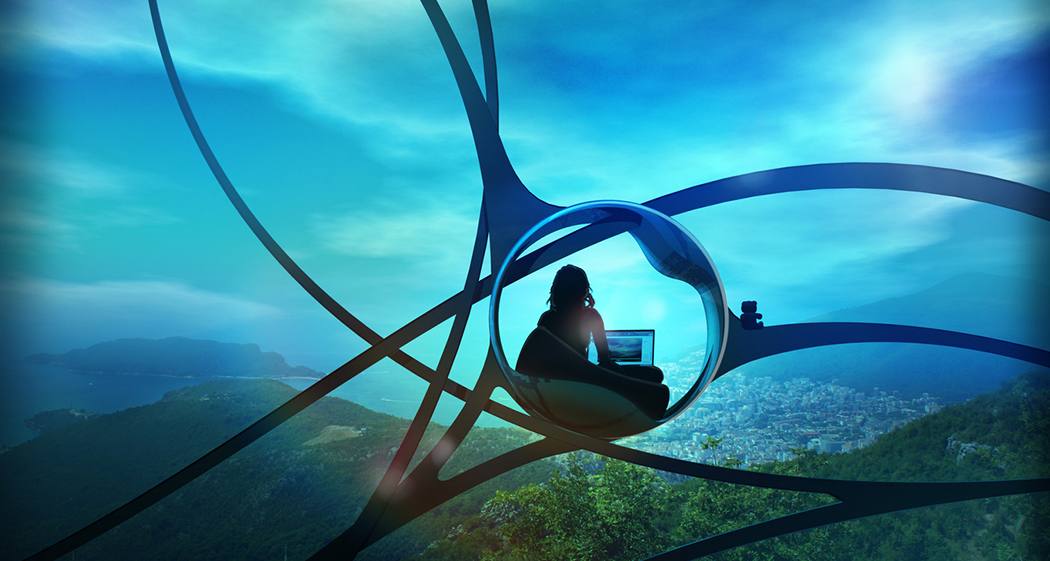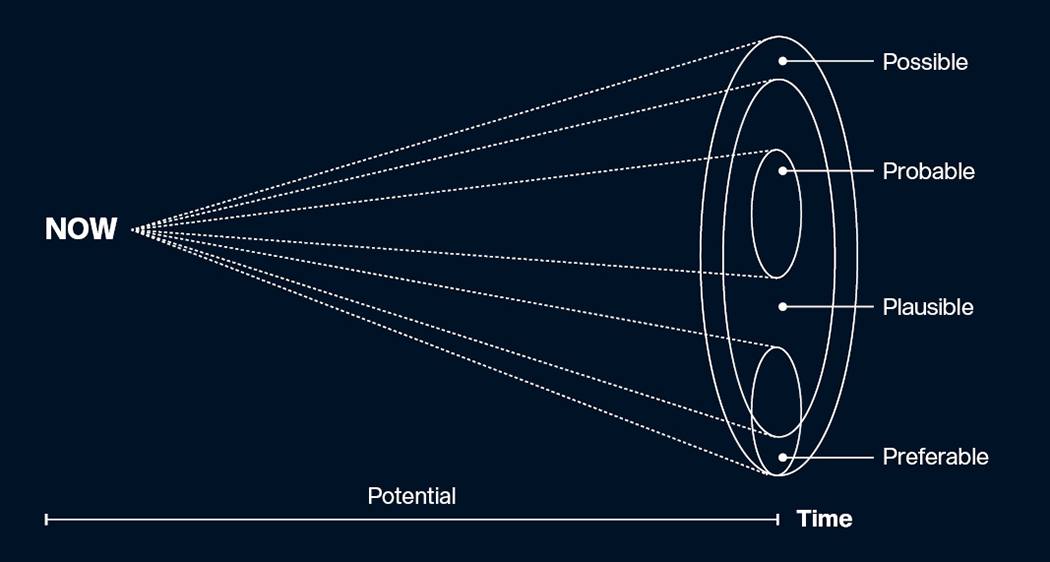
IESE Insight
4 scenarios to imagine the future
Reaching a better future starts now in the way you put your imagination to work and the steps you take to get where you want to go. Ready? Do try this at home!
"There is no single future 'out there' to be predicted. There are many alternative futures to be anticipated and pre-experienced to some degree." — Jim Dator, influential futurist
How do you imagine the future to be? Books and movies have long fantasized about the future. If Blade Runner 2049 is to be believed, in 27 years' time corporations will be fabricating bioengineered humans to serve as slaves. If that sounds too dystopian, IESE's José Ramón Pin recently wrote a book set in the year 4344 predicting the establishment of interstellar colonies, where the Church's outreach continues and, though it may be wishful thinking, we'll continue to enjoy pizza and ice cream!
Could imagining possible futures, like these, help guide us today? Could doing so even help us navigate toward a better future, potentially saving us from disaster?
These were some of the questions posed in an exhibition titled "The Great Imagination: Histories of the Future" and related workshops. The ideas of the influential futurist Jim Dator served as pillars for the exhibition, which was first held at the Espacio Fundación Telefónica in Madrid in the spring of 2022 and may be touring soon.
But before we understand where we are going, we need to understand where we are coming from. As Dator wrote: "It is not possible to think usefully and creatively about the future of anything until you understand its rationale for coming into existence, the many different facets of its past."
The future starts in the past
In the Western world, some of the very first portrayals of fictional futures emerged during the Industrial Revolution of the 18th century. Louis-Sebastien Mercier's novel L'An 2440, rêve s'il en fut jamais (The year 2440: A dream if ever there was one) is credited with spawning the genre of science fiction based on utopian visions of the future. Mercier wrote of an egalitarian future, a mere 18 years before the French Revolution of 1789, which highlights a core truth about futures thinking, as the exhibition noted: "The imagination is responding to a specific set of material and social circumstances that, in turn, makes the future possible. More than being a cultural curiosity or expression of the society that produces them, these images of the future actually play a role in animating and directing social change." In other words, futures thinking can conceivably accelerate historic change.
Yet it wasn't until the middle of the 20th century that future sparks really flew during what was known as the Great Acceleration. Earth scientists named it thus because of the dramatic jump in wealth, population, and the use of energy and natural resources — an acceleration that shows no sign of slowing down.
Ever since the first atomic bombs dropped in 1945, human interference in the Earth's ecology has become increasingly blatant. Human activity is "creating a new version of an old planet," wrote Peter Engelke and J.R. McNeill, co-authors of the book, The Great Acceleration: An environmental history of the Anthropocene since 1945.
Suffice to say that ever since the Great Acceleration began, exponential changes have fed our imaginations to dream up even more change. Particularly in modes of transportation, the means of communication and the design of cities (think Metropolis and Gotham), fiction has helped shape fact. Where next?

Organizing possible futures
Some futurists use the "futures cone" to depict the realm of what's possible, plausible, probable and preferable (as well as what's improbable). The cone's shape expresses the idea that the further we look ahead, the more open these futures become.
To organize our thinking, we return to Dator, who proposed that most future imaginings can be sorted into one (or more) of four categories, as explained below:
- Growth. Growth is by far the most common of the four alternative futures. It's a favorite subject of politicians, central bankers and businesspeople far and wide. Will the Great Acceleration ever end?
- Collapse. Moving in the opposite direction is a subject many avoid. But that doesn't mean "collapse," and what it might entail, shouldn't be seriously considered. What's more, Dator writes that collapse may not be a worst-case scenario. If it doesn't lead to extinction, it leads to a "lower" stage of development, which may usher in a simpler life or a return to less materialistic values.
- Discipline. Discipline may conjure images of dystopian, authoritarian controls — say, George Orwell's 1984 or Margaret Atwood's The Handmaid's Tale. Yet taming society's excesses or simply limiting energy use could help preserve finite resources. A disciplined future may be guided by values that are spiritual, natural, religious, political and/or cultural.
- Transformation. The transformation scenario is the most disruptive of the four. In Dator's view, "it anticipates and welcomes the transformation of all life, including humanity from its present form into a new 'posthuman' form, on an entirely artificial Earth, as part of the extension of intelligent life from Earth into the solar system and eventually beyond." Who is ready for that? Time to prepare!
Today's challenge
Approaching 2023, we seem to be at a crossroads. The world is emerging from a pandemic and dealing with the fallout of war, economic uncertainty and climate change, while still grappling with the repercussions of digitalization and artificial intelligence. In these turbulent times, rapid change is the reality for most people on Earth. And, as we've seen from the past, witnessing change begets imagining which begets more change.
Working with the exhibition, the Spanish design agency Prodigioso Volcán (full disclosure: they are the Art Directors of IESE Insight magazine) led workshops on overcoming common barriers to strategic thinking so that all of us can use our own great imaginations to create stories of the future that can be translated into strategic decision-making. Try this activity for yourself and/or with your teams.
Focus on a future point. Choose a year at random, a specific point in time at least 20 years from now. Then, assign a scenario of Growth, Collapse, Discipline or Transformation to that year. For example, what might Collapse look like in the year 2050? Of course, that depends on what is collapsing, when and how. You will also have to consider what would have to happen between now and then to move us there.
Bring in additional prompts. Factor in trends, macrotrends and signals, such as the six macro forces in the famous PESTEL framework:
- POLITICAL. Will democracy exist? With majority rule? Have any individual or collective rights been suppressed? Have any been expanded? How are international relations between nations faring? Does the concept of private property still exist?
- ECONOMIC. Which sectors of the economy are most important? Do banks exist? Which are the principal measures of growth or progress? Are we in crisis or has growth continued?
- SOCIAL. What demographic changes will we see: more old people, more young people, higher birthrates, higher mortality rates? What will the primary social structures be: will we identify primarily as families, couples,
individuals, communities or tribes? What will people's main concerns be? Which illnesses might we suffer from most? What will the principal cultural expressions look like, including customs and modes of living? - TECHNOLOGICAL. What will be the principal advances in technology in this future? What types of devices will be used each day at home, at work and in leisure time? Will Big Tech like Google and Facebook continue to exist? What role will technology play in teaching and learning?
- ENVIRONMENTAL. How will we get around? Will we live on Planet Earth? How will cities be? Will people continue to live in them? Will there be access to basic resources, such as water, food, energy and housing?
- LEGAL. What judicial systems exist? What is the regulatory role of the European Union? What about the United Nations and NATO? Do large multinationals face more or fewer restrictions? Does the death penalty exist?
Create a mood board. In addition to PESTEL prompts, try creating a "mood board" of interesting images, textures and colors to evoke your chosen year.
Create future time capsules. Using your PESTEL framework and mood board, identify specific trends to be analyzed further. Dig deeper into these trends and how they might evolve over time, again referring to Dator's four archetypes.
Finally, plan for your future. What could you do to move forward to your best future imaginable?
Time to roll up your sleeves and visualize how many futures might be possible, plausible, probable and preferable. Go ahead: Let your imagination run wild!
MORE INFO
Visit "The Great Imagination: Histories of the Future" (in Spanish).
"Alternative Futures at the Manoa School" by Jim Dator is published in the Journal of Futures Studies (2009).
Falling in love with the future by Miquel Lladó (Plataforma, 2021) offers a practical, business-oriented look at how to point yourself to, and prepare yourself for, the future career you want. Sharing his own work methodology as an executive in multinationals — as well as his wide-ranging readings as a teacher of strategy and management at IESE — Lladó encourages readers to put themselves in the very future that they aspire to, in order to make the best decisions to "lead us there and nowhere else."
A version of this article is published in IESE Business School Insight 162 (September 2022).
